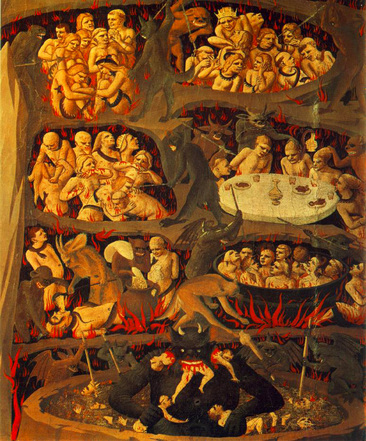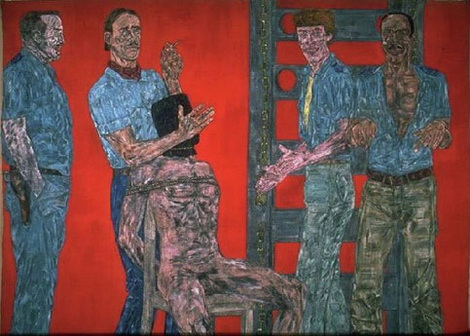



|
As a general rule, the best drawings are always done on the cheapest paper. The cheap paper does not intimidate. We're not afraid to "spoil" it. How easy it is to draw on copy paper or chipboard. Here are some examples.  I am beginning to get closer to a good likeness of Cassandra. Here she is on copy paper. I used charcoal, charcoal pencil, and watercolor pencil (which I did not wet).  Here a portrait of Drea, done in 10 minutes. Charcoal and charcoal pencil on copy paper.  A 30 minute drawing of Brianne, charcoal and charcoal pencil on copy paper.  And, my favorite model, Senalka. Charcoal and pastel on chipboard.
1 Comment
I hate to use the phrase "to beat a dead horse" in this context. But, I know everyone is tired of hearing about torture. It's yesterday's news. In the United States, those who are pragmatic and those who are idealists argue round and round and round. Let's see how artists have explored this subject.  Here, early Italian Renaissance painter Fra Angelico depicts the torture of the damned in Hell. The demons obviously enjoy their work. At the bottom of the painting, Satan eats the poor, lost souls with relish. This work would have been meant as a cautionary tale to the faithful, of what could happen if they persisted in sin. Angelico was known for the sweetness of his work, and had to find a different approach for this subject. I imagine it was unpleasant for him, and that he was relieved to return to painting the Virgin, the baby Jesus, angels.  Northern Renaissance painter Matthias Grunewald depicts perhaps the most famous torture victim in all of history, Jesus Christ upon the Cross. We are very familiar with the cleaned-up versions of the Crucifixion, the calm, alabaster Jesus, hardly marked, a few drops of blood at His hands, His feet, His side. Here Grunewald shows us something closer to reality. Crucifixion was death by slow torture. The Romans were particular masters of it.  Next, a Dutch woodcut shows "The Water Torture". Was this during the Inquisition? Or were these government officials seeking information? We do not know. The man writing in the book appears quite calm, as he waits for the words of the man being tortured. He is documenting the interrogation, it seems.  Moving on to modern times, this World War II poster starkly pronounces the difference between the Allies and the Axis. Implicit in this work is the assumption that good guys don't torture, only the evil do.  In his graphic novel Maus, Art Spiegelman tells the story of his father, a Holocaust survivor. As he flips back and forth from present to past, we see the lifetime pain and anguish suffered by the father, by Spiegelman's mother, a survivor who commits suicide, and by the artist himself as the son. The Jews are depicted as mice, the Germans as cats, the Poles as pigs. He had a difficult time finding a publisher for this work. The subject matter seemed so inappropriate for the comic book style. Finally published, Maus won many awards, including a Pulitzer Prize Special Award in 1992.  In his Mercenaries series of the 1980's, the late American artist Leon Golub explored the dark world of those who fight, brutalize and kill for hire. As do the demons in Hell, his soldiers of fortune enjoy their work. We see the camaraderie of men engaged in a common activity. He said of his work: Artists are part of the information process... Visual history is important in providing a record of what is going on – levels of intention, levels of confidence, levels of aggression or control.  Best known for his paintings of pleasantly plump people engaged in light-hearted harmless activities, Columbian artist Fernando Botero also has turned his attention to the dark world of brutality and violence. To the left we see a painting of a drug cartel's victims, men, women and children gunned down in the seemingly never ending cycle of violence in his native land. Below, we see him with one of his paintings depicting the events at Abu Ghraib. Fra Angelico was commissioned to paint Hell and was no doubt relieved to return to depicting the Virgin with Baby Jesus, choirs of angels, etc. But, Botero chose these unpleasant subjects as a testimony to the world.  Cambodian artist Vann Nath is one of only seven survivors of the notorious Khmer Rouge prison S-21. About 14,000 people -men, women and children-perished in that horrific place. His skill as an artist saved him. He was put to work doing portraits of Khmer Rouge leader Pol Pot. Now, his paintings expose the brutal torture inflicted there. He has said: But during that whole time I kept wondering if the Khmers were simply destroying themselves. I wondered, how can we do this to ourselves? Is it self-hatred? Are we trying to wipe ourselves from the face of the earth?  What of myself as an artist? I have no political work to show. But, I have treated the subject of the Crucifixion. The work to the left is titled "Through Mary's eyes". As Mary was transfixed in helpless anguish, standing by the Cross, she must have still seen the little boy she loved. Below, we see her crazy with with grief over the lifeless body of her son. No loving mother wishes to outlive her child. And to see him die a slow death by torture must have ripped out her heart. Did she see the coming Resurrection? We do not know. Yesterday evening, an art reception. In an unusual venue. HIll Country Bible Church NW presents the most cutting-edge exhibits in northwest Austin and, I believe, could compete with any gallery in the city. Over 45 artists presented work in many different media, including painting, sculpture, watercolor, drawings, mosaic, glass, lettering arts, ceramics, mixed media. Plus, the cake is awesome.  For the first time, I exhibited not only paintings, but also digital photographs. I received the most comments on one of the photographs, "Closer". I found this broken car side-mirror while walking with my dog on an undeveloped property in my suburban neighborhood. How long had it lain there? I do not know. It's brokenness called out to me. The sky reflected in the chunks of glass seemed such a poignant image. For now we see through a glass, darkly, but then face to face: now I know in part; but then shall I know even as also I am known. (βλέπομεν γὰρ ἄρτι δι’ ἐσόπτρου ἐν αἰνίγματι, τότε δὲ πρόσωπον πρὸς πρόσωπον· ἄρτι γινώσκω ἐκ μέρους, τότε δὲ ἐπιγνώσομαι καθὼς καὶ ἐπεγνώσθην.)  I brought a friend. I believe it was her first visit to an art opening reception. And, as I said, the cake was awesome.  Ah, a family vacation. I did get to slip away to some art museums. Here I am, in a blurry iPhone photo, copying the body language of a sculpture at the Los Angeles County Museum of Art. The LACMA has a wonderful collection of German Expressionist works and an equally wonderful collection of Japanese art. What a contrast! The raw, dramatic work of the German Expressionists versus the spare serenity of of the Japanese. For information about LACMA, see the website at: http://www.lacma.org/  And here my husband views the photo he just took on his iPhone of the Rembrandt hanging before him. Awesome!  In San Francisco, I visited the Jewish Museum of Contemporary Art. Among the exhibits, "As It Is Written: Project 304,805." AKA the Torah Projects. Here is the description from the website: "As It Is Written: Project 304,805 is centered around a soferet (a professionally trained female scribe) who while on public view will write out the entire text of the Torah over the course of a full year." Very moving. Check it out on their website: http://www.thecjm.org/  Also in San Francisco, I visted the San Francisco Museum of Modern Art. The most moving piece I found? A sculpture by Magdalena Abrakanowicz. Here website describes her work as "emotive...and disturbing." Very apt. "Four on a Bench"  Many, many works at SFMOMA. Of particular note, an exhibit of works by Chuck Close. Much, much more of course. For more info, check out the website at: http://www.sfmoma.org/  And in Portland, Oregon, the Portland Art Museum. Two wonderful exhibits: "The Bible Illuminated: R. Crumb's Book of Genesis" and "A Pioneering Collection: Master Drawings from the Crocke For more info on the Portland Museum of Art, see the website: http://portlandartmuseum.org/  In addition, a small exhibit of works by Leon Golub. (For more info on Leon Golub, refer to Wikipedia: http://en.wikipedia.org/wiki/Leon_Golub ) Here is this piece, on view in Portland, from his "Mercenaries" series. I am drawn to beauty, but beauty can be found in work that would not be considered "beautiful" by most casual observers. I find his work deeply moving as it depicts the depravity that still lurks in the heart of humanity.
Start blogging by creating a new post. You can edit or delete me by clicking under the comments. You can also customize your sidebar by dragging in elements from the top bar.
|
Archives
November 2023
|